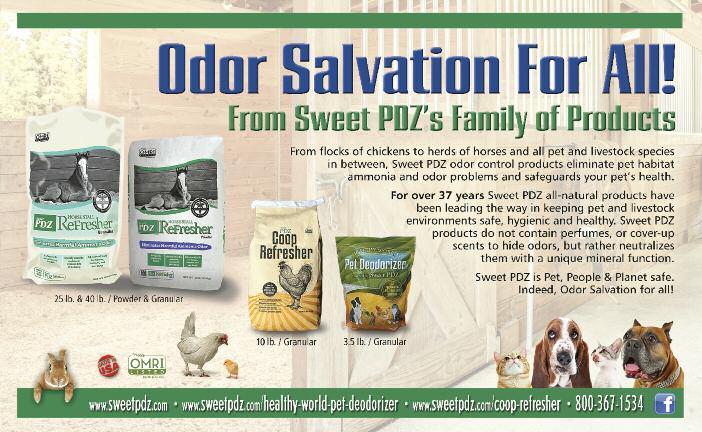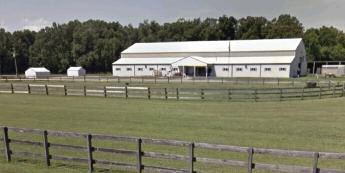
9 minute read
Horse HeAltH/WelfAre
8. February, 2022 • ©Mid-South Horse Review • www.midsouthhorsereview. com Horse Health & Welfare
Dunlap Equine Services
Advertisement
Inpatients, outpatients, and isolation patients are housed separately within the clinic complex. dunlap equine services, owned by Jennifer dunlap, dvm, has expanded operations to a new equine veterinary clinic at 22495 Highway 194, somerville,tN.Ambulatory service for farm calls continues to be available in the west tennessee, east Arkansas and north mississippi area, but this new facility allows dunlap equine to expand its offerings.
With the design of the clinic, outpatients, aka haul in appointments, inpatients, and isolation patients can be housed separately to keep all patients safer. the clinic includes 26 stalls with four of those being iCu stalls with special fluid pumps, and there are two extra large stalls for draft horses and mares and foals. there are indoor and outdoor arenas for lameness workups and an in-house and online pharmacy and an advanced in-house lab. the site for the clinic was chosen for ease of access off of i-40 (at exit 35) and because even the largest 18-wheeler can easily circle within the complex, allowing for over-the-road horse haulers to be able to unload safely. A dedicated farrier area was placed in the outpatient barn for therapeutic farrier needs. this area was also designed to allow for plenty of client education semi-
nars.
Client education seminars have been planned for every other month for 2022. they will vary from hands-on workshops, such as a leg bandaging workshop held on January 21, 2022, to large scale seminars, such as A sports medicine Approach to lameness from both the veterinarian and farrier perspectives being held march 21, 2022 by dr. Jennifer dunlap and farrier daniel Bishop. the clinic is open for regular haul in appointments and 24/7 for emergencies. find more information at: https://www.dunlapequineservices.com/ and on facebook.
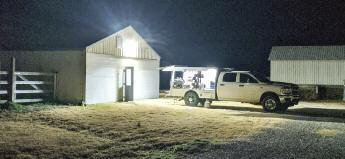
The complex was designed with plenty of room for a farrier station.
The ability to host client education seminars, such as this bandaging clinic, played a big role in the design of the facility.

Wintertime Equine Nutrition: 3 Facts
Help horses weather the winter with insight from equine nutritionists and a veterinarian From Aimee Robinson, Valley Vet Supply
While impressively stout yet entirely fragile, horses require a great level of care, especially as it relates to their nutrition over the winter.
“many horse owners may not realize they actually need to feed horses differently in the wintertime than they do in the summertime, ” Jyme Nichols, Phd, director of nutrition at stride Animal Health, shared in an interview with valley vet supply.
Here are three main facts to consider.
Fact 1: A Horse’s “thermoneutral Zone” directly impacts their Nutritional Needs.
“the first thing that i think is important for everybody to understand is a term that sounds a little bit intimidating — thermoneutral zone, ” dr. Nichols said. “this is basically the temperature outside in which a horse can maintain their own core body temperature without having to exert any extra effort to regulate either their heat loss or heat gain. ”
Horses in the united states have an average thermoneutral zone between 40 and 80 degrees, which means horses near the low end of their thermoneutral zone will have to use extra energy (thus calories) to maintain heat. to identify whether your horse is outside of their thermoneutral zone, “you want to pay attention to whether or not they ’re using any natural defenses to that cold weather, ” explained Brittany rahm, nutrition consultant at stride Animal Health. these natural defenses can include: • shivering • standing with tail to the wind, head lowered • seeking shelter dr. Nichols followed up, “Anytime you combine cold temperatures on top of moisture – wind, ice and snow – a horse will have to increase their heat production and will need to consume more calories. Additionally, young horses or underweight horses are going to hit that lower, critical temperature and get colder faster than a mature horse or a horse that’s going into wintertime with really good body condition. ”
An especially important detail for those traveling for competitions or pleasure with their horses is that it takes two weeks to a full month for horses to readapt to a new ambient temperature.
“When traveling, be mindful if you're going a long distance or to a region that has a very different temperature range than what you ’re coming from – your horse may struggle a little bit more to retain heat or try to get rid of it – depending whether you ’re going to a colder climate or a hotter climate, ” said dr. Nichols.
Fact 2: A Horse’s feed sources Will Helpthem maintainWarmth, inAddition to Weight. it’s important to understand “metabolic heat production” as it relates to increasing a horse’s feed during cold temperatures. dr. Nichols explained, “think of a horse’s digestive system, or their hind gut, as a furnace.the more the microbes in the horse’s hind gut are able to digest and ferment – especially fibers – the more heat that can be generated for that horse.that’s part of what goes into keeping them warm. ”
Fact 3:AsWeather Changes, so should a Horse’s diet, But Not in the Way some may think.
“Alot of times, people can get hung up thinking, ‘i need to change my horse’s grain, or i need to change how much grain i feed, ’” dr. Nichols said. However, is either necessary? Not exactly, but there are some other aspects for horse owners to consider.
While a well-meaning sentiment, increasing grain can be harmful to a horse’s health – heightening colic risk and more –and secondly, doing so may not be enough to help a horse maintain their warmth when they need it most.
“increasing the amount of hay is the best way to increase heat production and keep a horse warm during winter, ” dr. Nichols said. “Horses will naturally increase the amount of hay that they eat, based on the temperatures dropping. ” regarding how much more hay to provide, remember that the average thermoneutral zone for horses in the u.s. is between 40 and 80 degrees. dr. Nichols said, as a general rule of thumb, for every one-degree fahrenheit below the lower range of 40 degrees, horses will need an extra 200 calories.
“so, to put that in perspective, your average hay is going to have between 800 to 1,000 calories per pound. let's say you've got a 10-degree drop – you're going to need an extra 2,000 calories.All i did there was just take that 10 degrees times 200 calories, and that gets me to 2,000 calories, which is roughly 2 to 3 lbs. extra hay per day. so, if you're feeding small square bales of grass hay, that’s probably going to be an extra flake, maybe an extra two flakes. ”
Horse owners will need to increase their horse’s hay intake, but what about their grain? When the temperatures drop, upping feed is a common practice, but not recommended. dr. Nichols gave two specific horse health examples: should horses be fed either a (Continued on p. 10)
texashaynet.com
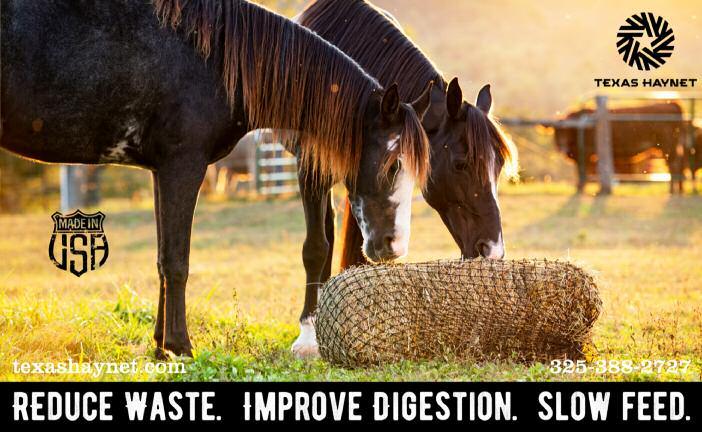
325-388-2727
10. February 2022 • ©Mid-South Horse Review • www.midsouthhorsereview. com Wintertime Nutrition (Cont. from p. 9) fortified feed or cereal grains, such as whole corn and oats? example 1, fortified feed increase – if horsemen are feeding a fortified grain at a recommended level of 4 lbs. per day, then increase by 1 lb. per day. that feed is designed to meet all vitamin, mineral requirements, amino acid requirements, etc., at 4 lbs. per day. While that extra pound may not be more harmful, it will provide some extra calories, but the calories will be more quickly digested. this means the increased grain does not provide horses with long-term heat production, like hay does. example 2, cereal grain increase – say horsemen are feeding a whole corn/oat mix at 4 lbs. per day and decide to double it. Corn and oats are really high in starches and sugars, which puts a really heavy load of sugar on the digestive tract that the small intestine can't digest very well or very quickly. you can then have an overspill of starch into the hind gut of the horse, impacting the balance of the good bacteria in that gut and presenting colic issues; it can also cause founder or laminitis issues in some horses.
“you want to keep your grain level the same. if you're going to increase anything, the most important thing to do is increase the hay and consider a supplement that will keep them drinking, ” rahm said. for senior horses or horses with poor dental conditions, both rahm and dr. Nichols recommend feeding forage pellets, such astimothy or alfalfa hay pellets, or even beet pulp shreds, which all have similar benefits as long-stem hay forage. “for horses who are underweight, it is important to try to improve their body condition, which will support their thermoregulation and overall health. in addition to increasing their total hay intake, we recommend adding a high-quality protein and energy supplement to help support healthy weight gain, ” said tony Hawkins, dvm, technical service veterinarian at valley vet supply. Bundle up, stay safe, and keep in mind these three facts to help your horse weather the winter.
dr. stephanie golm joined tennessee equine Hospital West as an equine intern in June 2021 before moving to the memphis location at the beginning of the year. she graduated from the university ofWisconsin school of veterinary medicine in may 2021 with an emphasis in equine medicine. she was born and raised in the midwest, and moved to tennessee just before starting with teH. she said, “i've wanted to be a veterinarian since i was about three years old. i have a passion for all animals, but developed a love for horses at a young age. i grew up both riding for fun and showing in the hunter/jumper circuit through college. i enjoy all aspects of equine medicine, but sports medicine and dentistry are my biggest passions. my husband, luke, has been in the military for the past three and a half years, so when i'm not working i enjoy spending time with him and our cat, ember. ” inAugust 2019, golm worked with the horses owned by the lakota People at Pine ridge reservation. she wrote: “it was a privilege to be able to provide veterinary service to the horses that belong to the lakota People. it was amazing to see both the need and how much they care for these animals. Not only did i learn a lot from the amazing doctors and students on this trip, i learned so much from the people themselves. it was humbling to learn about their history and lifestyle. these people are amazing horsemen and women, and it was an experience i will always cherish. ”
Her other experiences include kennel assistant at indian Prairie Animal Hospital, vet tech at south trail Animal Hospital, and large animal vet student at uW veterinary Care. she reminds animal owners: “remember to be kind to your veterinarians. in the end, all we want is what’s best for you and the animals whom we’ ve dedicated our lives to helping. ”
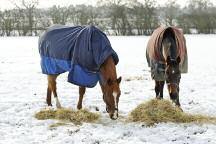
Dr. Stephanie Golm
